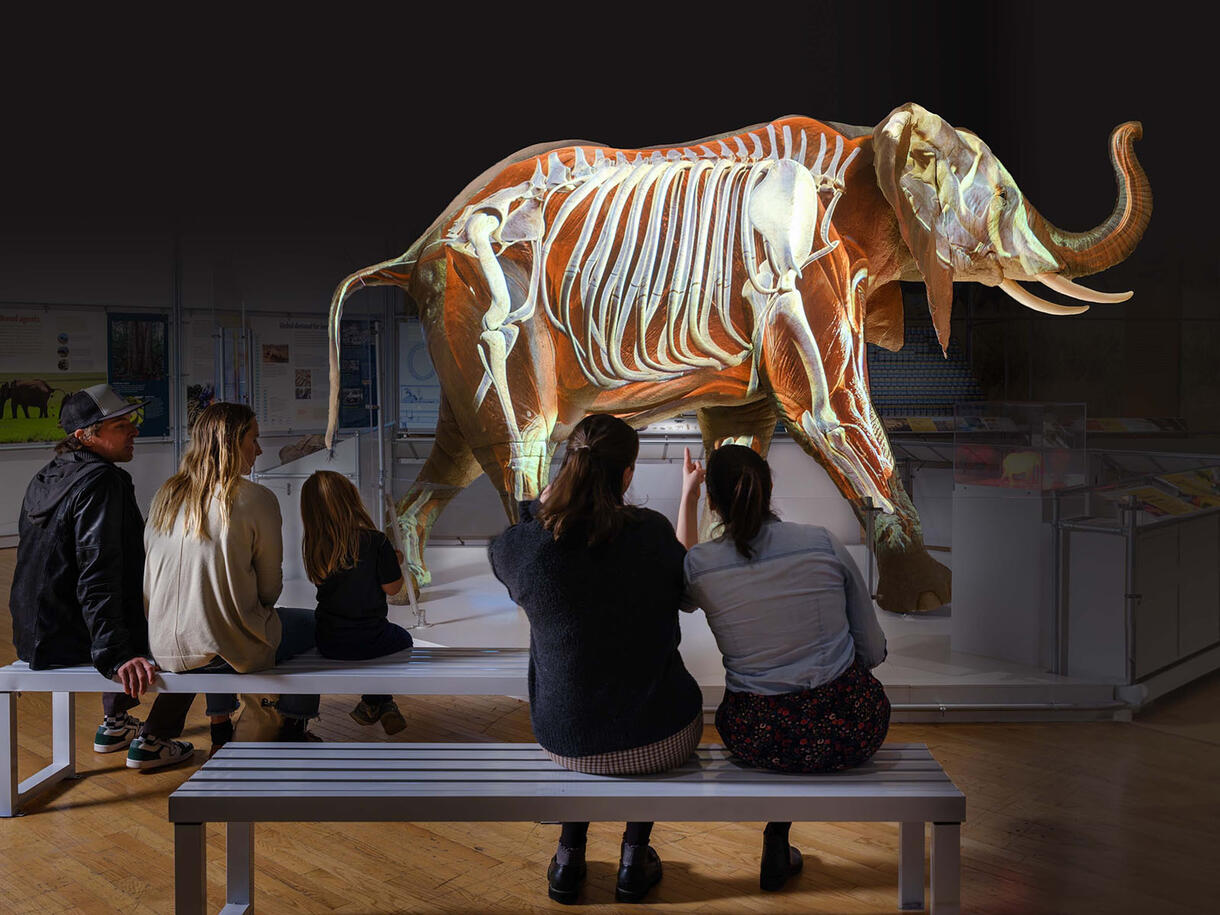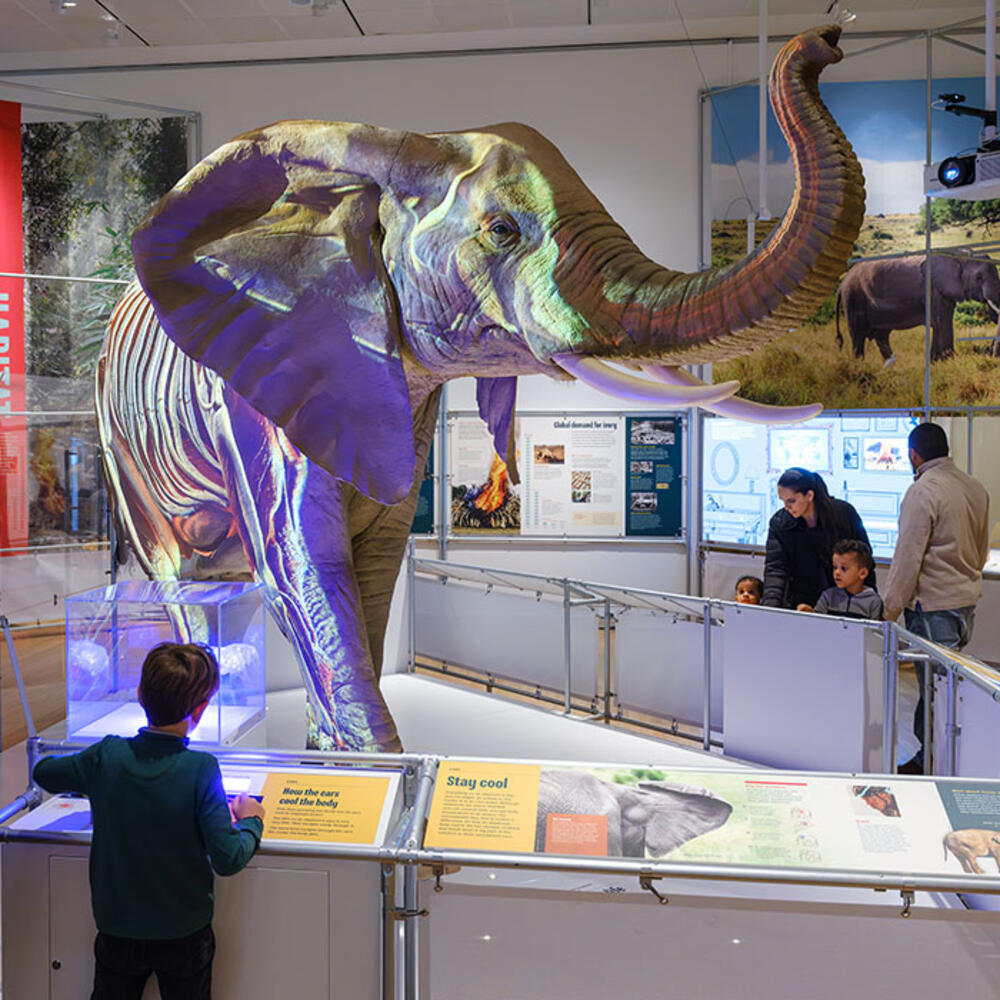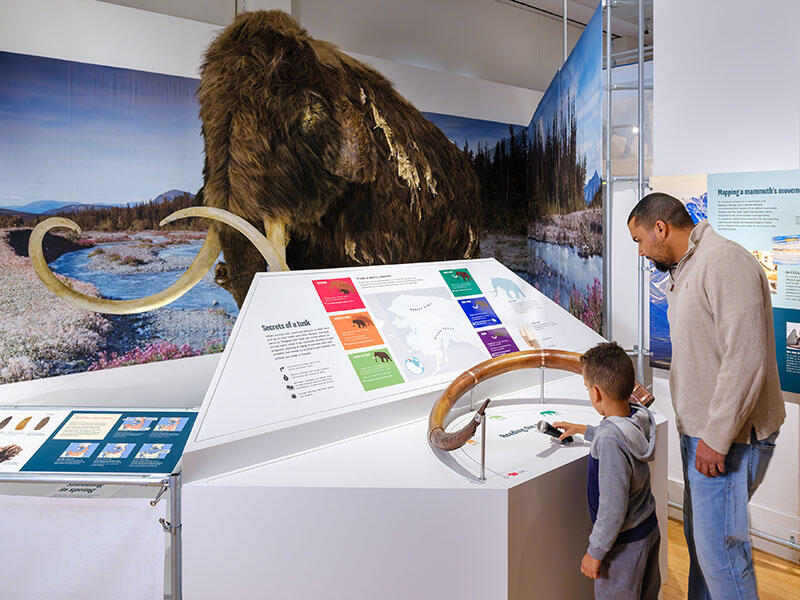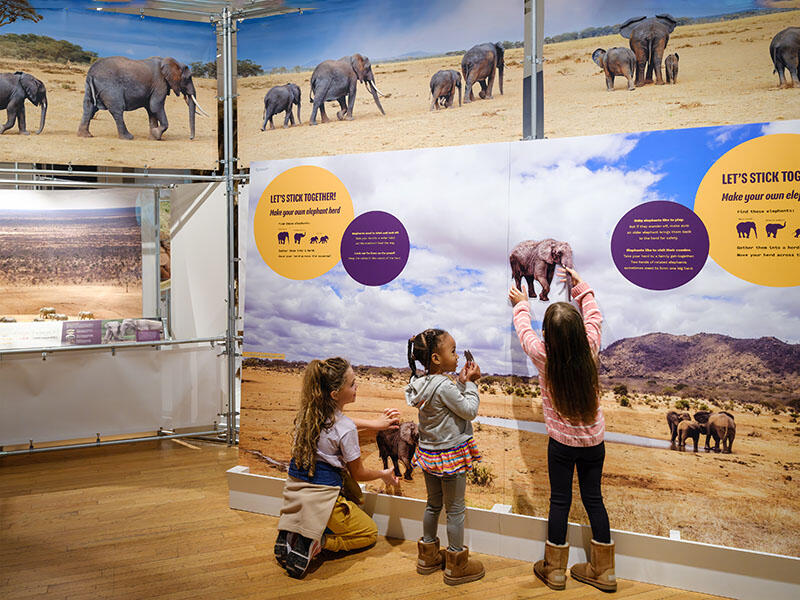The Secret World of Elephants
Opened November 13, 2023
Additional ticket required. Free for Members.
Floor 4, LeFrak Family Gallery

Use the 40,000 muscles in their trunks? Or reshape the forests and savannas they live in, creating an environment upon which many other species rely?
The Secret World of Elephants reveals new science about both ancient and modern elephants, including elephants’ extraordinary minds and senses, why they’re essential to the health of their ecosystems, and inspiring efforts to overcome threats to their survival.
 Alvaro Keding/© AMNH
Alvaro Keding/© AMNH
[Elephants walking across grasslands.]
NARRATOR: Did you know that, unlike most mammals, elephants can’t jump?
[Close-up of an elephant’s feet walking toward the viewer.]
NARRATOR: Elephants evolved to walk on their tiptoes, supported by flat pads of fat. That helps them carry all that weight, but doesn’t let them catch any air.
[Two elephants play-fighting in water.]
NARRATOR: Then again, when you weigh 8,000 pounds, why would you need to jump?
[Elephants silhouetted against an orange and yellow sunset.]
NARRATOR: Elephants have captured the hearts and imaginations of humans throughout history. Today they’re some of the most beloved animals out there.
[Slow-motion close-up of an elephant flapping its ears toward the camera.]
NARRATOR: But how much do you really know about these huge, tusked herbivores?
One: elephants’ closest living relatives have fur…and flippers.
[A large group of elephants splashes in a watering hole.]
NARRATOR: Who shows up at an elephant family reunion?
[Side-by-side clips of a rhinoceros and hippopotamuses]
NARRATOR: Did the rhinoceros or hippopotamus come to mind?
[Several clips of rhinoceroses and hippopotamuses grazing in their natural habitats]
NARRATOR: Actually, what these animals have in common–like their size and thick skin–are what we call convergent evolution. That’s when distantly related organisms independently evolve similar adaptations to their environment.
[A herd of elephants walks close together in the grass]
NARRATOR: So what IS the elephant’s closest living kin? Believe it or not…it’s these guys: hyraxes and sea cows.
[Side-by-side footage of a hyrax, a small mammal covered in fur that resembles a rodent, and a manatee seen from underwater in a patch of seagrass.]
NARRATOR: DNA sequencing has revealed that elephants belong in a superorder called Afrotheria along with their closest relatives, including aardvarks, elephant shrews, golden moles, tenrecs, and closest of all, hyraxes and sea cows.
[As the narrator lists each animal, a photograph of each is highlighted.]
NARRATOR: Surprising as it may seem, these cousins do actually have a lot in common.
Manatees, for example, have prehensile upper lips that work like a mini version of a trunk—grasping and pulling food into their mouths.
[Underwater clip of a manatee using its upper lip to grab a free-floating plant from the water’s surface.]
NARRATOR: They also have remnants of elephant-like toenails on their flippers.
[A manatee spins underwater, showing several small nails on the edge of its flipper.]
NARRATOR: Hyraxes have hoof-like nails and large tusk-looking incisor teeth. And like elephants, they have complex communication and social lives.
[Two hyraxes sitting on a rock nuzzle each other.]
NARRATOR: Two: elephant tusks are time capsules.
[Close-up view of an elephant’s tusks where they emerge from its face.]
NARRATOR: An elephant’s tusks–which are actually its very, very long incisor teeth– keep growing throughout its lifetime, as new layers of tissue develop and push the existing layers further away from its jaw.
[A young elephant holds grass in its trunk and takes a bite.]
NARRATOR: The new layers contain chemical isotopes from whatever the elephant was eating at the time they formed, capturing information about the animal’s location and health over its lifetime.
[Footage of the woolly mammoth fossil skeleton on view at the American Museum of Natural History.]
NARRATOR: Scientists were able to use this technique to reconstruct the life story of a wooly mammoth—a close extinct relative of the Asian elephant.
[Photograph of a scientist working with a cross-section of a mammoth tusk.]
NARRATOR: Analyzing the isotopes in a mammoth tusk sample, the researchers mapped its movements and diet across thousands of miles in prehistoric Alaska, helping shed light on elephant evolution.
[Model diorama of prehistoric Alaska with woolly mammoths and a mastodon.]
NARRATOR: Three: elephants use tools and solve problems.
With the largest brains of any land animal, and trunks strong enough to uproot trees yet nimble enough to pick up individual leaves, it’s no wonder that elephants are great at problem-solving.
[An elephant rips a small tree out of the ground with its trunk. Close-up of the tip of an elephant’s trunk sorting through long, thin leaves.]
NARRATOR: They’ve been known to use tools to do things like getting rid of pests and defending themselves.
The stick is a great example.
[Close-up of an elephant breaking off the end of a stick.]
NARRATOR: Elephants can trim a stick to a useful length for scratching their backs, holding down tree branches, and swatting away insects.
[An elephant holds a leafy branch in its trunk and gently swats itself.]
NARRATOR: And elephants can also use their ingenuity to avoid doing work for humans. In Southeast Asia, elephants that perform labor for human handlers during the day are known to stuff their “work bells” with leaves at night so their handlers can’t find them for their morning “shifts.”
Four: elephant families stick together
[A group of elephants of varying ages and sizes walks together through a grassy plane with thick trees in the background.]
NARRATOR: Elephant herds are groups of closely related females and their young. Male elephants, or bulls, leave the herd as teenagers.
[A lone elephant walks by itself.]
NARRATOR: A herd’s matriarch, an older female leader, helps the group survive by sharing her hard-earned wisdom, like remembering the locations of far-away watering holes in times of drought.
These family groups grow very attached. Mothers are extremely protective of their calves, and younger females who haven’t had their own calves yet are attentive babysitters.
Elephants show their affection through touch, especially with their trunks, as well as through gesture and sound. Individual elephants remember their feelings for one another even when separated for years.
Although rarely documented, when a family member dies, elephants appear to grieve the loss. They’ll gather around the body and touch it with their trunks, nudge it, or pick it up.
Five: elephants are Versatile Communicators.
Elephants use a truly impressive range of sounds to express themselves, including rumbles…
[A juvenile elephant makes a RUMBLING SOUND while standing with his companions.]
NARRATOR: …trumpets, roars, and more.
[An elephant close to the camera flicks its trunk at the viewer and makes a TRUMPETING SOUND.]
NARRATOR: They’ll use particular kinds of sounds to scare off predators, comfort distressed calves, decide which direction to move in, and greet relatives they haven’t seen in a while.
Some elephants use contact calls–deep rumbling sounds–to get in touch with family members who are out of sight. These calls can reach up to nearly a mile away! Studies even show that elephants can specifically recognize the sounds of their relatives.
Elephants can also make a low-frequency infrasonic rumbling—a sound that humans can’t hear, but other elephants can detect with their feet. It’s kind of like how you can feel the vibrations of a speaker at a concert, except elephants can detect their friends’ vibrations up to 20 miles away!
Six: elephants and people can work together.
We have a long history together.
[A series of slides shows historical examples of humans utilizing elephants as follows:
A sandstone depiction of humans riding elephants as part of a procession. Text on-screen reads, “Mauryan Empire, India, 3rd Century BCE”
An ancient Roman sarcophagus also depicting riders on elephants as part of procession. Text on screen reads “Roman Empire, 2nd Century CE.”
An illuminated manuscript depicting archers riding into battle on elephants. Text on screen reads “Kingdom of Armenia, 15th Century CE.”
A black-and-white photograph of an elephant pulling a cart with machinery on a paved city street with a trolly in the background. Text on screen reads, “United Kingdom, 1916.”]
NARRATOR: Elephants can learn over 100 commands, and humans have historically used elephants’ size, strength, and smarts to our advantage for warfare, work, and entertainment.
[In modern times, an elephant pulls a large log attached to a harness.]
NARRATOR: Globally, humans are moving away from using elephants as work animals. Many places in the United States have banned using wild animals like elephants in circuses…
[Old black-and-white footage of an elephant being used as part of a circus.]
NARRATOR: …and some zoos are phasing out elephant enclosures, due in large part to societal pressure and growing awareness of elephants’ complex social needs.
[A lone elephant picks at grass in a zoo habitat.]
NARRATOR: But elephants can still have an important economic impact while living in their natural habitat.
[A safari vehicle drives past a group of elephants at sunset.]
NARRATOR: For example, they can be a big draw for ecotourism–responsible travel to admire the natural world–which can benefit local economies while promoting conservation efforts.
[Elephants drink from a body of water, partially obscured by trees and shrubs.]
NARRATOR: This is just a small peek into the fascinating, and sometimes secretive, world of elephants.
[Close-up of an Asian elephant’s face as it chews blades of long grass.]
NARRATOR: Imagine how much else there is to know about these complex and charismatic giants.
[Credits.]
Reserve Museum Tickets
»
Select the number of tickets, and date/time for Museum entry, and you will be then able to add The Secret World of Elephants, and/or additional ticketed exhibitions during checkout.
What You’ll See in The Secret World of Elephants
 An interactive mammoth tusk model demonstrates how scientists use isotope “fingerprints” to reveal how mammoths traveled across what is now Alaska about 17,000 years ago.
An interactive mammoth tusk model demonstrates how scientists use isotope “fingerprints” to reveal how mammoths traveled across what is now Alaska about 17,000 years ago.Alvaro Keding/© AMNH
 Visitors can create their own elephant herd with a selection of large magnets representing the matriarch—the leader—as well as other female adults and calves.
Visitors can create their own elephant herd with a selection of large magnets representing the matriarch—the leader—as well as other female adults and calves.Alvaro Keding/© AMNH
Elephant Evolution
Once, animals with tusks and trunks lived on almost every continent and many islands. Today only three elephant species survive.
Explore the group to which elephants belong—the proboscideans, from the world “proboscis,” meaning trunk—and encounter a life-size model of one of the giants of the Ice Age: a woolly mammoth, depicted in the process of shedding its winter coat.
Bodies and Minds
Discover the latest science about modern elephants’ anatomy and behavior—from trunks strong enough to pull down a tree yet nimble enough to pluck a blade of grass to their amazing vocalization behaviors, problem-solving, and more.
See a full-scale model of an African elephant, enhanced with a projection offering an inside look at how this massive mammal processes between 300 and 500 pounds of food a day, and experience interactive exhibits that illustrate how elephants use very low sound waves to send messages through the ground—to other elephants’ feet.
Elephants and Us
For thousands of years, elephants and humans have lived together—often uneasily, sometimes competing for the same resources. Elephants remain powerful religious and political symbols across cultures.
Explore humans’ life with elephants, including conflict and conservation, through exhibits that examine the impact of killing elephants for ivory, how climate change is affecting elephants, and ways that humans and elephants can share the planet.